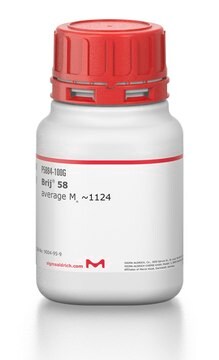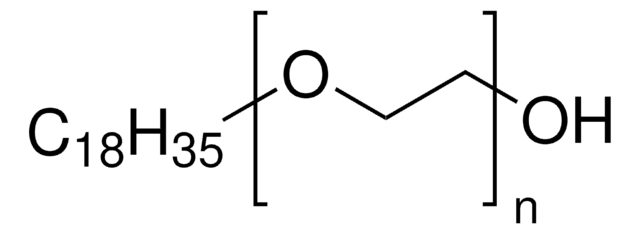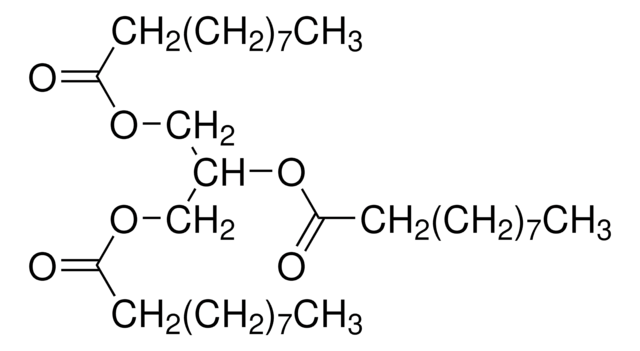P4019
Brij® S20
Synonym(s):
Polyethylene glycol octadecyl ether, Polyoxyethylene (20) stearyl ether
About This Item
Recommended Products
form
solid
Quality Level
mp
44-46 °C (lit.)
HLB
15
SMILES string
CCCCCCCCCCCCCCCCCCOCCOCCOCCOCCOCCOCCOCCOCCOCCOCCOCCOCCOCCOCCOCCOCCOCCOCCOCCOCCO
InChI
1S/C20H41O2/c1-2-3-4-5-6-7-8-9-10-11-12-13-14-15-16-17-19-22-20-18-21/h2-20H2,1H3
InChI key
PSEGVHKUPXNGGJ-UHFFFAOYSA-N
Looking for similar products? Visit Product Comparison Guide
Related Categories
General description
Application
- Nanostructured lipid carriers for oral delivery of silymarin: Improving its absorption and in vivo efficacy in type 2 diabetes and metabolic syndrome model.: This study utilizes Brij® S20 to develop nanostructured lipid carriers for oral delivery of silymarin. The findings demonstrate enhanced absorption and efficacy of silymarin in treating type 2 diabetes and metabolic syndrome, highlighting the potential of Brij® S20 in improving drug delivery systems. (Piazzini et al., 2019).
- Water-stable all-biodegradable microparticles in nanofibers by electrospinning of aqueous dispersions for biotechnical plant protection.: The study uses Brij® S20 to create water-stable, biodegradable microparticles in nanofibers through electrospinning. These microparticles are designed for biotechnical plant protection, demonstrating the potential of Brij® S20 in agricultural biotechnology. (Bansal et al., 2012).
Legal Information
comparable product
Signal Word
Warning
Hazard Statements
Precautionary Statements
Hazard Classifications
Acute Tox. 4 Oral
Storage Class Code
11 - Combustible Solids
WGK
WGK 2
Flash Point(F)
Not applicable
Flash Point(C)
Not applicable
Personal Protective Equipment
Certificates of Analysis (COA)
Search for Certificates of Analysis (COA) by entering the products Lot/Batch Number. Lot and Batch Numbers can be found on a product’s label following the words ‘Lot’ or ‘Batch’.
Already Own This Product?
Find documentation for the products that you have recently purchased in the Document Library.
Customers Also Viewed
Our team of scientists has experience in all areas of research including Life Science, Material Science, Chemical Synthesis, Chromatography, Analytical and many others.
Contact Technical Service






